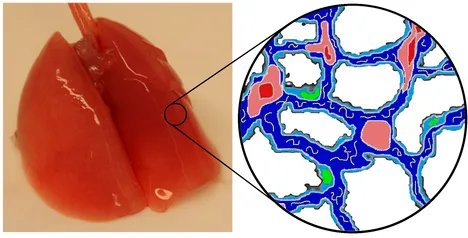Material Modeling: Constituent-based Models
Diseases like acute lung injury (ALI) or acute respiratory distress syndrom (ARDS) can cause an inhomogeneous alteration of lung tissue, which, during mechanical ventilation, can lead to over stretching of healthy tissue regions. To get a better understanding of the under lying processes causing the changes in material parameters, a sophisticated material model, accounting for the contribution of the different load-bearing tissue constituents, i.e. collagen fibers, elastin fi bers and the ground substance, is essential. So far only the qualitative in uence of these constituents has been investigated.
To determine constituent based material models for soft biological tissue, instead of just introducing the method in an abstract way, we demonstrate it along with an important application - namely the development of a new constituent based material model for rat lung parenchyma.
Core ingredients of the method are collagenase and elastase experiments. For our speci c application specimens were chosen to be living precision-cut lung slices (PCLS). Such an advanced material description is essential to get a better understanding of ventilator-induced lung injury (VILI). With this method we are able to determine a quantitative, constituent based material description for lung parenchyma.

First we determined the in uence of the three load-bearing constituents by performing uni-axial tensile tests on PCLS. In the corresponding protocol first untreated specimens were tested. Then these specimens were treated with collagenase/elastase to destroy the corresponding fiber family, before repeating the experimental protocol. The specimens were then treated with the corresponding other protease and experiments were repeated.
The experimentally gained stress-strain curves showed that the fiber-fi ber interaction strongly in uences the material behavior. For this reason the proposed material description has four constituents: the collagen fi bers, the elastin fibers, the ground substance and an additional term representing fi ber- fiber interaction.
The contribution of the ground substance has an additional volumetric part. This novel material description will be useful for sophisticated simulations of parenchymal mechanics, especially for predictive simulation of diseases, where the fiber content is altered in the tissue.
(in cooperation with Prof. Uhlig)
